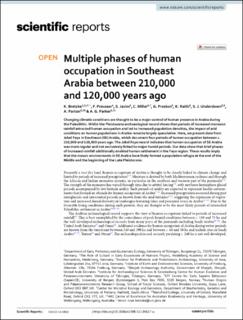| dc.contributor.author | Bretzke, K. | |
| dc.contributor.author | Preusser, F. | |
| dc.contributor.author | Jasim, S. | |
| dc.contributor.author | Miller, Christopher | |
| dc.contributor.author | Preston, G. | |
| dc.contributor.author | Raith, K. | |
| dc.contributor.author | Underdown, S.J. | |
| dc.contributor.author | Parton, A. | |
| dc.contributor.author | Parker, A.G. | |
| dc.date.accessioned | 2022-08-10T07:00:14Z | |
| dc.date.available | 2022-08-10T07:00:14Z | |
| dc.date.created | 2022-05-13T10:56:46Z | |
| dc.date.issued | 2022 | |
| dc.identifier.issn | 2045-2322 | |
| dc.identifier.uri | https://hdl.handle.net/11250/3010952 | |
| dc.description.abstract | Changing climatic conditions are thought to be a major control of human presence in Arabia during the Paleolithic. Whilst the Pleistocene archaeological record shows that periods of increased monsoon rainfall attracted human occupation and led to increased population densities, the impact of arid conditions on human populations in Arabia remains largely speculative. Here, we present data from Jebel Faya in Southeast (SE) Arabia, which document four periods of human occupation between c. 210,000 and 120,000 years ago. The Jebel Faya record indicates that human occupation of SE Arabia was more regular and not exclusively linked to major humid periods. Our data show that brief phases of increased rainfall additionally enabled human settlement in the Faya region. These results imply that the mosaic environments in SE Arabia have likely formed a population refugia at the end of the Middle and the beginning of the Late Pleistocene. | en_US |
| dc.language.iso | eng | en_US |
| dc.publisher | Nature Research | en_US |
| dc.rights | Navngivelse 4.0 Internasjonal | * |
| dc.rights.uri | http://creativecommons.org/licenses/by/4.0/deed.no | * |
| dc.title | Multiple phases of human occupation in Southeast Arabia between 210,000 and 120,000 years ago | en_US |
| dc.type | Journal article | en_US |
| dc.type | Peer reviewed | en_US |
| dc.description.version | publishedVersion | en_US |
| dc.rights.holder | Copyright The Author(s) 2022 | en_US |
| dc.source.articlenumber | 1600 | en_US |
| cristin.ispublished | true | |
| cristin.fulltext | original | |
| cristin.qualitycode | 1 | |
| dc.identifier.doi | 10.1038/s41598-022-05617-w | |
| dc.identifier.cristin | 2024282 | |
| dc.source.journal | Scientific Reports | en_US |
| dc.identifier.citation | Scientific Reports. 2022, 12, 1600. | en_US |
| dc.source.volume | 12 | en_US |

